Organisational Behaviour Principles Applied: Marks and Spencer Report
VerifiedAdded on 2023/01/12
|10
|2891
|76
Report
AI Summary
This report provides an analysis of organisational behaviour principles, focusing on Marks and Spencer. It begins with an introduction to organisational behaviour and its impact on business functions, then applies Charles Handy's model of organisational culture, examining power, task, person, and role cultures, and considering their relevance to Asda. The report further explores the impact of corporate culture on employee performance, including innovation, employee turnover, and corporate image. It then delves into communication theories, specifically the Shannon-Weaver model, as applied within ASDA. Finally, it investigates leadership styles, focusing on path-goal theory and its application to different employee types and task requirements, with an emphasis on the achievement-oriented leadership style. The report concludes by highlighting the importance of adapting leadership styles to suit specific situations and employee characteristics.
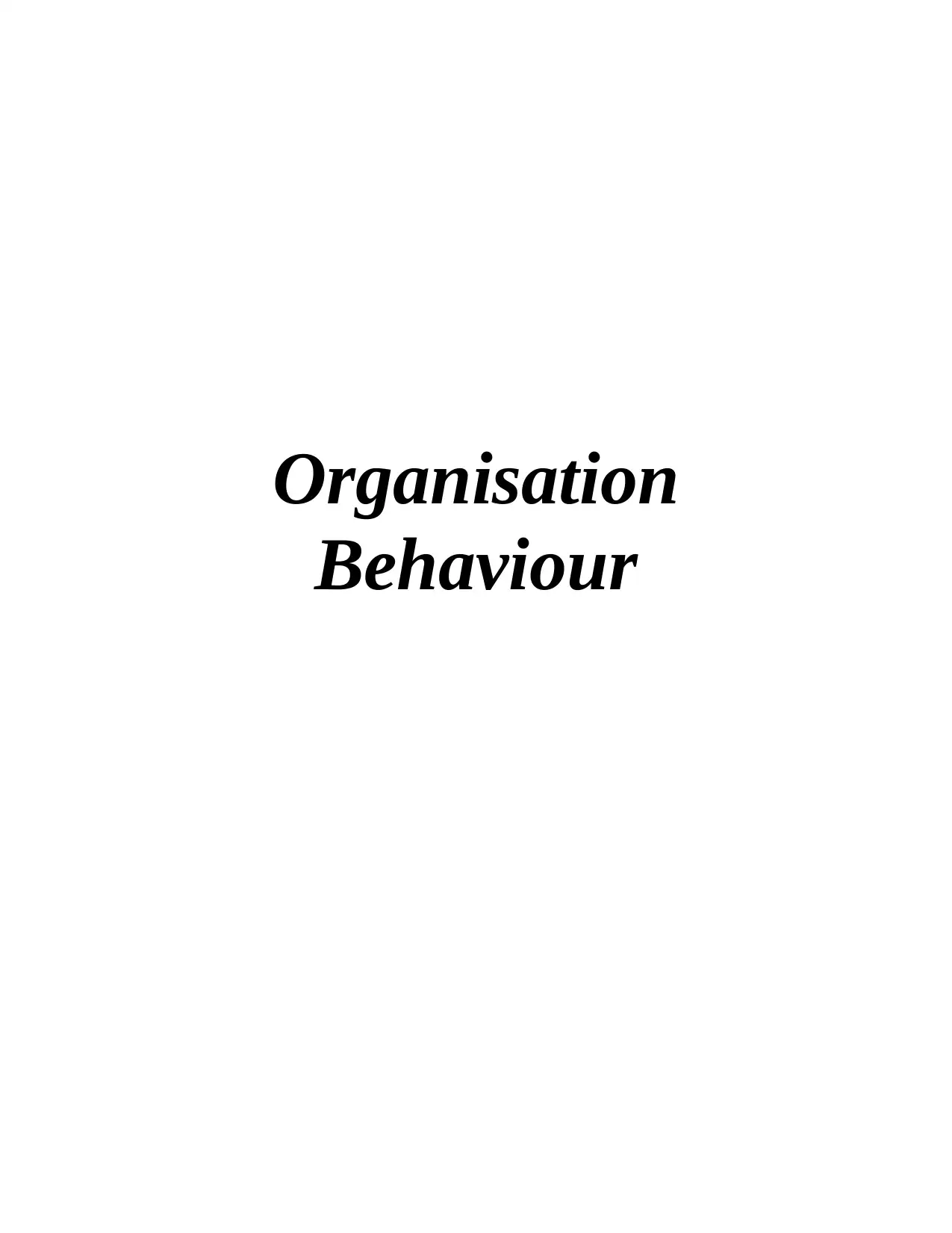
Organisation
Behaviour
Behaviour
Paraphrase This Document
Need a fresh take? Get an instant paraphrase of this document with our AI Paraphraser
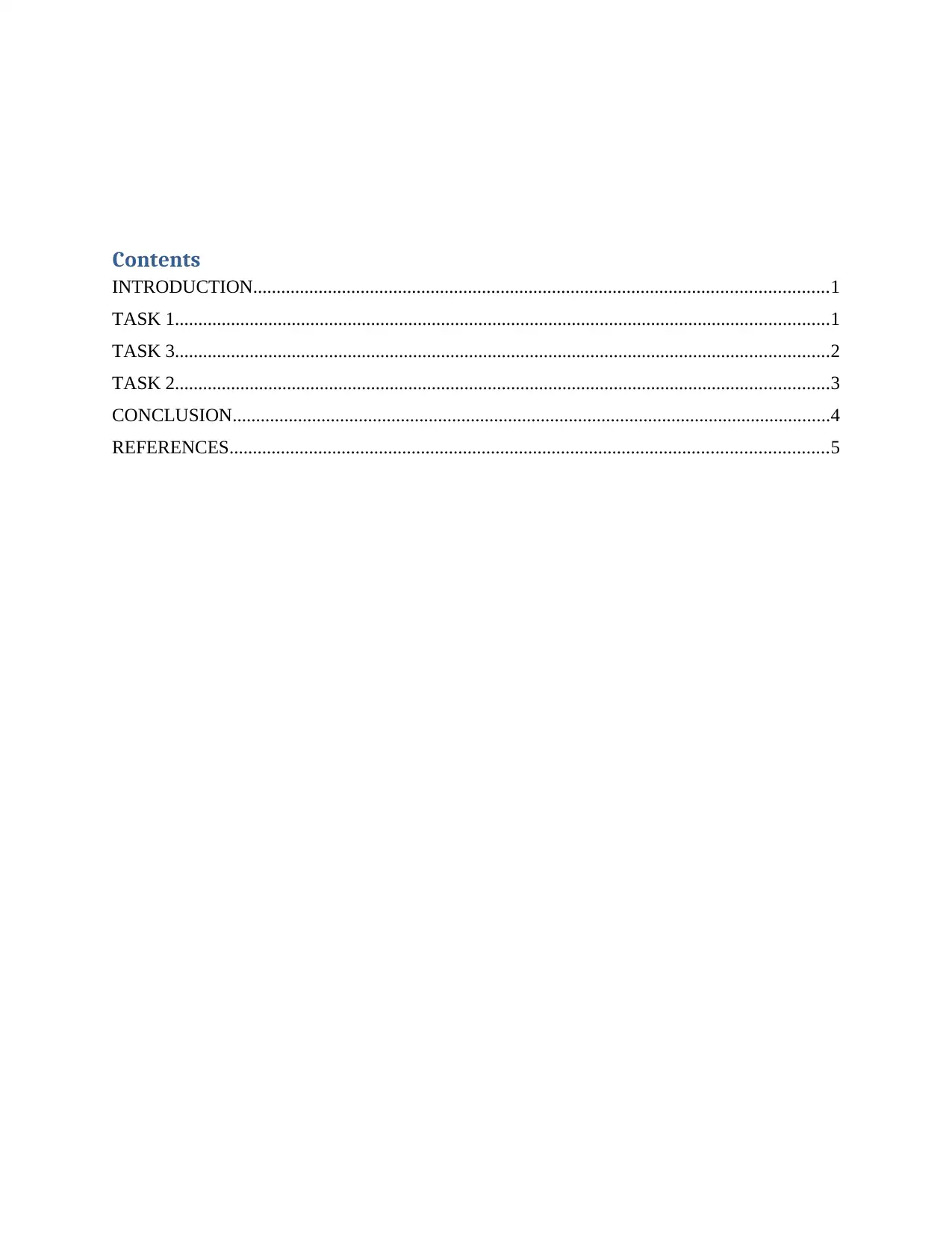
Contents
INTRODUCTION...........................................................................................................................1
TASK 1............................................................................................................................................1
TASK 3............................................................................................................................................2
TASK 2............................................................................................................................................3
CONCLUSION................................................................................................................................4
REFERENCES................................................................................................................................5
INTRODUCTION...........................................................................................................................1
TASK 1............................................................................................................................................1
TASK 3............................................................................................................................................2
TASK 2............................................................................................................................................3
CONCLUSION................................................................................................................................4
REFERENCES................................................................................................................................5
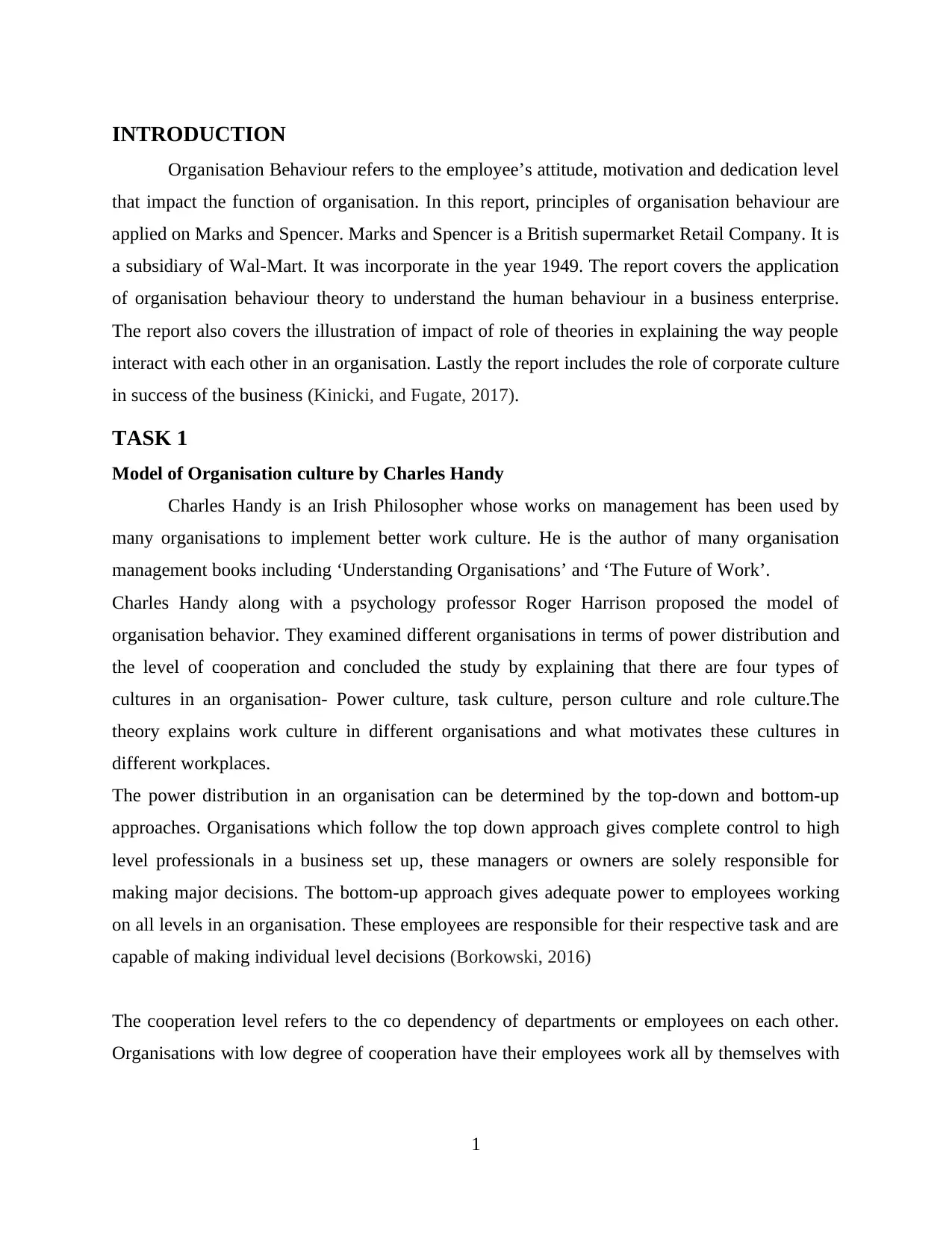
INTRODUCTION
Organisation Behaviour refers to the employee’s attitude, motivation and dedication level
that impact the function of organisation. In this report, principles of organisation behaviour are
applied on Marks and Spencer. Marks and Spencer is a British supermarket Retail Company. It is
a subsidiary of Wal-Mart. It was incorporate in the year 1949. The report covers the application
of organisation behaviour theory to understand the human behaviour in a business enterprise.
The report also covers the illustration of impact of role of theories in explaining the way people
interact with each other in an organisation. Lastly the report includes the role of corporate culture
in success of the business (Kinicki, and Fugate, 2017).
TASK 1
Model of Organisation culture by Charles Handy
Charles Handy is an Irish Philosopher whose works on management has been used by
many organisations to implement better work culture. He is the author of many organisation
management books including ‘Understanding Organisations’ and ‘The Future of Work’.
Charles Handy along with a psychology professor Roger Harrison proposed the model of
organisation behavior. They examined different organisations in terms of power distribution and
the level of cooperation and concluded the study by explaining that there are four types of
cultures in an organisation- Power culture, task culture, person culture and role culture.The
theory explains work culture in different organisations and what motivates these cultures in
different workplaces.
The power distribution in an organisation can be determined by the top-down and bottom-up
approaches. Organisations which follow the top down approach gives complete control to high
level professionals in a business set up, these managers or owners are solely responsible for
making major decisions. The bottom-up approach gives adequate power to employees working
on all levels in an organisation. These employees are responsible for their respective task and are
capable of making individual level decisions (Borkowski, 2016)
The cooperation level refers to the co dependency of departments or employees on each other.
Organisations with low degree of cooperation have their employees work all by themselves with
1
Organisation Behaviour refers to the employee’s attitude, motivation and dedication level
that impact the function of organisation. In this report, principles of organisation behaviour are
applied on Marks and Spencer. Marks and Spencer is a British supermarket Retail Company. It is
a subsidiary of Wal-Mart. It was incorporate in the year 1949. The report covers the application
of organisation behaviour theory to understand the human behaviour in a business enterprise.
The report also covers the illustration of impact of role of theories in explaining the way people
interact with each other in an organisation. Lastly the report includes the role of corporate culture
in success of the business (Kinicki, and Fugate, 2017).
TASK 1
Model of Organisation culture by Charles Handy
Charles Handy is an Irish Philosopher whose works on management has been used by
many organisations to implement better work culture. He is the author of many organisation
management books including ‘Understanding Organisations’ and ‘The Future of Work’.
Charles Handy along with a psychology professor Roger Harrison proposed the model of
organisation behavior. They examined different organisations in terms of power distribution and
the level of cooperation and concluded the study by explaining that there are four types of
cultures in an organisation- Power culture, task culture, person culture and role culture.The
theory explains work culture in different organisations and what motivates these cultures in
different workplaces.
The power distribution in an organisation can be determined by the top-down and bottom-up
approaches. Organisations which follow the top down approach gives complete control to high
level professionals in a business set up, these managers or owners are solely responsible for
making major decisions. The bottom-up approach gives adequate power to employees working
on all levels in an organisation. These employees are responsible for their respective task and are
capable of making individual level decisions (Borkowski, 2016)
The cooperation level refers to the co dependency of departments or employees on each other.
Organisations with low degree of cooperation have their employees work all by themselves with
1
⊘ This is a preview!⊘
Do you want full access?
Subscribe today to unlock all pages.

Trusted by 1+ million students worldwide
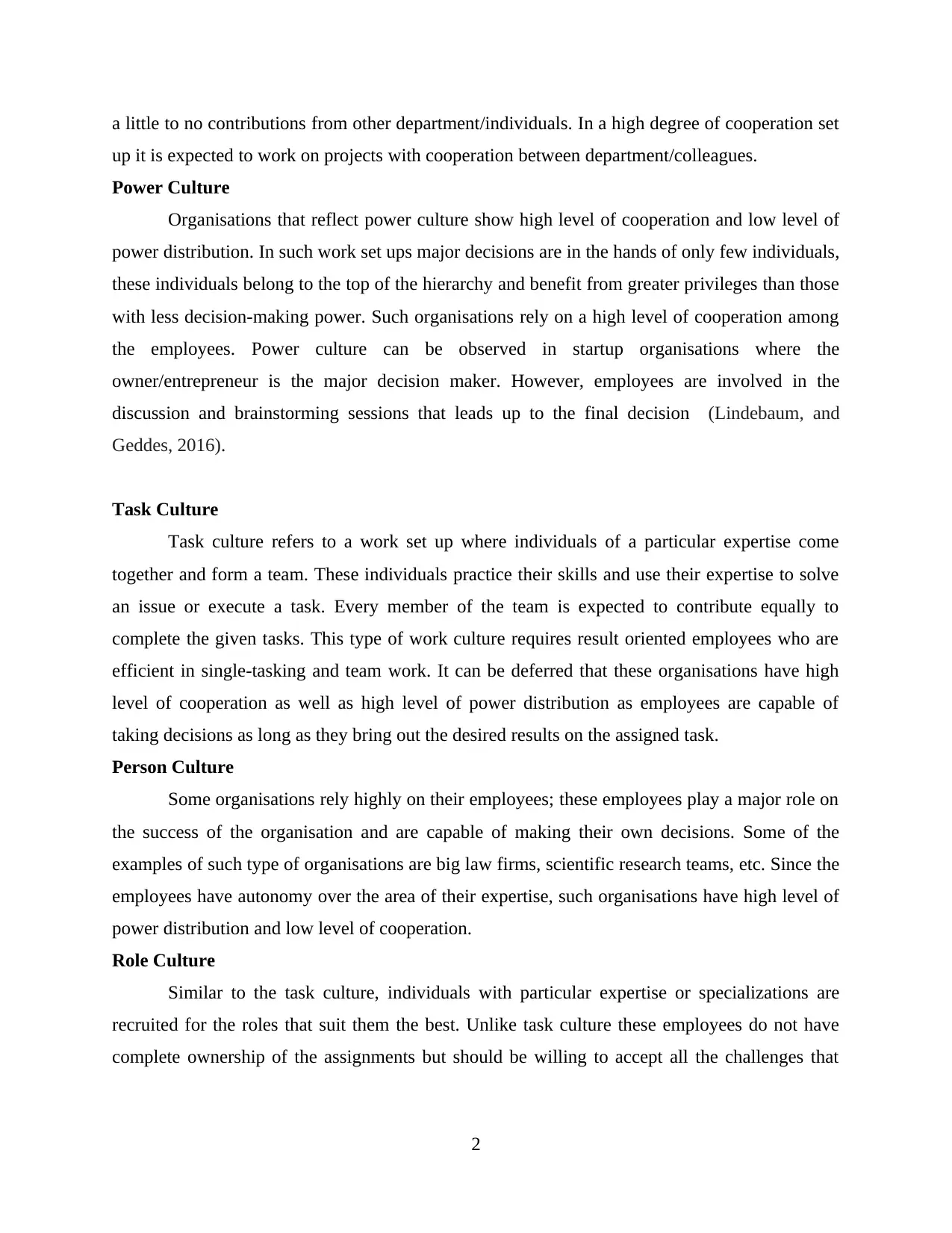
a little to no contributions from other department/individuals. In a high degree of cooperation set
up it is expected to work on projects with cooperation between department/colleagues.
Power Culture
Organisations that reflect power culture show high level of cooperation and low level of
power distribution. In such work set ups major decisions are in the hands of only few individuals,
these individuals belong to the top of the hierarchy and benefit from greater privileges than those
with less decision-making power. Such organisations rely on a high level of cooperation among
the employees. Power culture can be observed in startup organisations where the
owner/entrepreneur is the major decision maker. However, employees are involved in the
discussion and brainstorming sessions that leads up to the final decision (Lindebaum, and
Geddes, 2016).
Task Culture
Task culture refers to a work set up where individuals of a particular expertise come
together and form a team. These individuals practice their skills and use their expertise to solve
an issue or execute a task. Every member of the team is expected to contribute equally to
complete the given tasks. This type of work culture requires result oriented employees who are
efficient in single-tasking and team work. It can be deferred that these organisations have high
level of cooperation as well as high level of power distribution as employees are capable of
taking decisions as long as they bring out the desired results on the assigned task.
Person Culture
Some organisations rely highly on their employees; these employees play a major role on
the success of the organisation and are capable of making their own decisions. Some of the
examples of such type of organisations are big law firms, scientific research teams, etc. Since the
employees have autonomy over the area of their expertise, such organisations have high level of
power distribution and low level of cooperation.
Role Culture
Similar to the task culture, individuals with particular expertise or specializations are
recruited for the roles that suit them the best. Unlike task culture these employees do not have
complete ownership of the assignments but should be willing to accept all the challenges that
2
up it is expected to work on projects with cooperation between department/colleagues.
Power Culture
Organisations that reflect power culture show high level of cooperation and low level of
power distribution. In such work set ups major decisions are in the hands of only few individuals,
these individuals belong to the top of the hierarchy and benefit from greater privileges than those
with less decision-making power. Such organisations rely on a high level of cooperation among
the employees. Power culture can be observed in startup organisations where the
owner/entrepreneur is the major decision maker. However, employees are involved in the
discussion and brainstorming sessions that leads up to the final decision (Lindebaum, and
Geddes, 2016).
Task Culture
Task culture refers to a work set up where individuals of a particular expertise come
together and form a team. These individuals practice their skills and use their expertise to solve
an issue or execute a task. Every member of the team is expected to contribute equally to
complete the given tasks. This type of work culture requires result oriented employees who are
efficient in single-tasking and team work. It can be deferred that these organisations have high
level of cooperation as well as high level of power distribution as employees are capable of
taking decisions as long as they bring out the desired results on the assigned task.
Person Culture
Some organisations rely highly on their employees; these employees play a major role on
the success of the organisation and are capable of making their own decisions. Some of the
examples of such type of organisations are big law firms, scientific research teams, etc. Since the
employees have autonomy over the area of their expertise, such organisations have high level of
power distribution and low level of cooperation.
Role Culture
Similar to the task culture, individuals with particular expertise or specializations are
recruited for the roles that suit them the best. Unlike task culture these employees do not have
complete ownership of the assignments but should be willing to accept all the challenges that
2
Paraphrase This Document
Need a fresh take? Get an instant paraphrase of this document with our AI Paraphraser
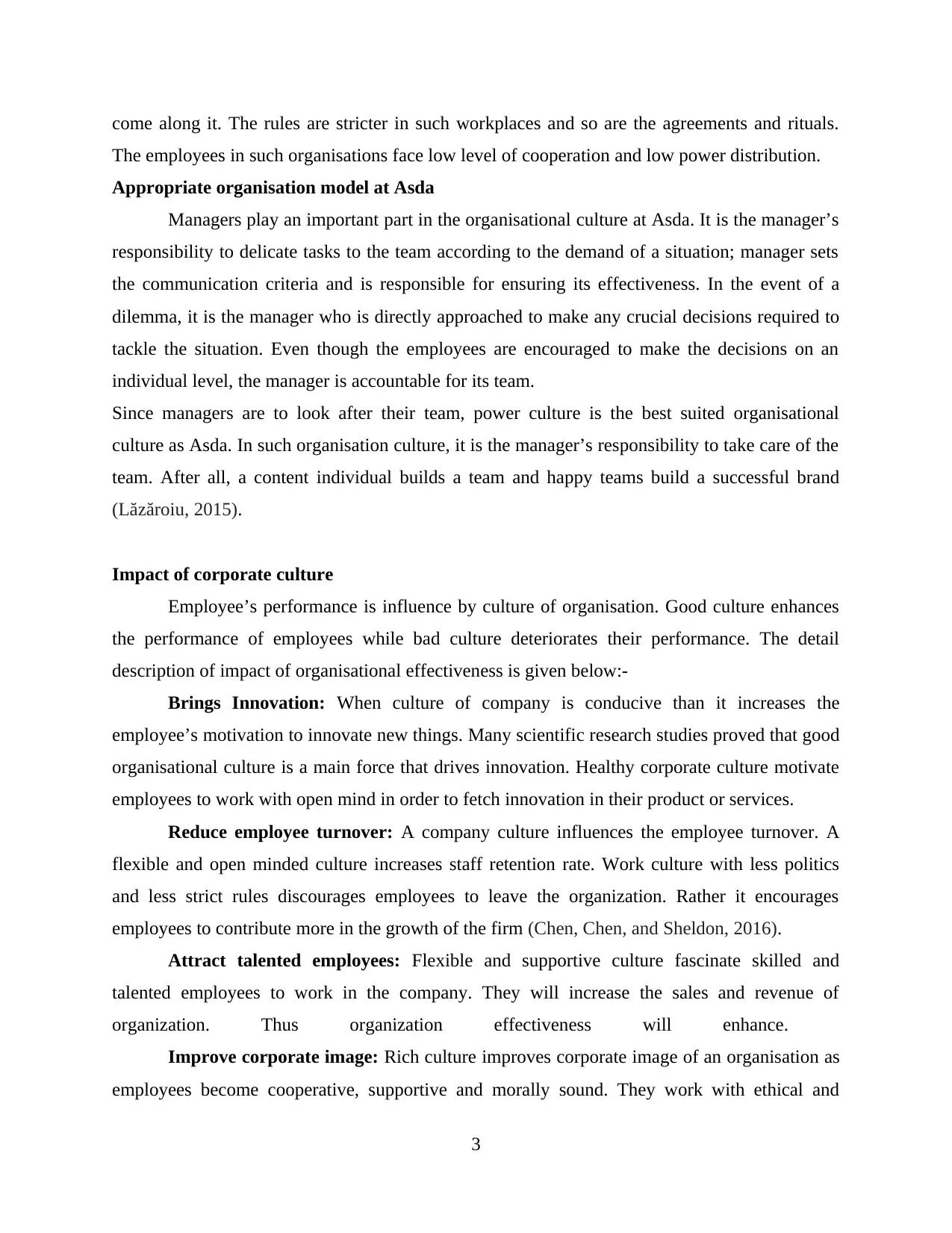
come along it. The rules are stricter in such workplaces and so are the agreements and rituals.
The employees in such organisations face low level of cooperation and low power distribution.
Appropriate organisation model at Asda
Managers play an important part in the organisational culture at Asda. It is the manager’s
responsibility to delicate tasks to the team according to the demand of a situation; manager sets
the communication criteria and is responsible for ensuring its effectiveness. In the event of a
dilemma, it is the manager who is directly approached to make any crucial decisions required to
tackle the situation. Even though the employees are encouraged to make the decisions on an
individual level, the manager is accountable for its team.
Since managers are to look after their team, power culture is the best suited organisational
culture as Asda. In such organisation culture, it is the manager’s responsibility to take care of the
team. After all, a content individual builds a team and happy teams build a successful brand
(Lăzăroiu, 2015).
Impact of corporate culture
Employee’s performance is influence by culture of organisation. Good culture enhances
the performance of employees while bad culture deteriorates their performance. The detail
description of impact of organisational effectiveness is given below:-
Brings Innovation: When culture of company is conducive than it increases the
employee’s motivation to innovate new things. Many scientific research studies proved that good
organisational culture is a main force that drives innovation. Healthy corporate culture motivate
employees to work with open mind in order to fetch innovation in their product or services.
Reduce employee turnover: A company culture influences the employee turnover. A
flexible and open minded culture increases staff retention rate. Work culture with less politics
and less strict rules discourages employees to leave the organization. Rather it encourages
employees to contribute more in the growth of the firm (Chen, Chen, and Sheldon, 2016).
Attract talented employees: Flexible and supportive culture fascinate skilled and
talented employees to work in the company. They will increase the sales and revenue of
organization. Thus organization effectiveness will enhance.
Improve corporate image: Rich culture improves corporate image of an organisation as
employees become cooperative, supportive and morally sound. They work with ethical and
3
The employees in such organisations face low level of cooperation and low power distribution.
Appropriate organisation model at Asda
Managers play an important part in the organisational culture at Asda. It is the manager’s
responsibility to delicate tasks to the team according to the demand of a situation; manager sets
the communication criteria and is responsible for ensuring its effectiveness. In the event of a
dilemma, it is the manager who is directly approached to make any crucial decisions required to
tackle the situation. Even though the employees are encouraged to make the decisions on an
individual level, the manager is accountable for its team.
Since managers are to look after their team, power culture is the best suited organisational
culture as Asda. In such organisation culture, it is the manager’s responsibility to take care of the
team. After all, a content individual builds a team and happy teams build a successful brand
(Lăzăroiu, 2015).
Impact of corporate culture
Employee’s performance is influence by culture of organisation. Good culture enhances
the performance of employees while bad culture deteriorates their performance. The detail
description of impact of organisational effectiveness is given below:-
Brings Innovation: When culture of company is conducive than it increases the
employee’s motivation to innovate new things. Many scientific research studies proved that good
organisational culture is a main force that drives innovation. Healthy corporate culture motivate
employees to work with open mind in order to fetch innovation in their product or services.
Reduce employee turnover: A company culture influences the employee turnover. A
flexible and open minded culture increases staff retention rate. Work culture with less politics
and less strict rules discourages employees to leave the organization. Rather it encourages
employees to contribute more in the growth of the firm (Chen, Chen, and Sheldon, 2016).
Attract talented employees: Flexible and supportive culture fascinate skilled and
talented employees to work in the company. They will increase the sales and revenue of
organization. Thus organization effectiveness will enhance.
Improve corporate image: Rich culture improves corporate image of an organisation as
employees become cooperative, supportive and morally sound. They work with ethical and
3
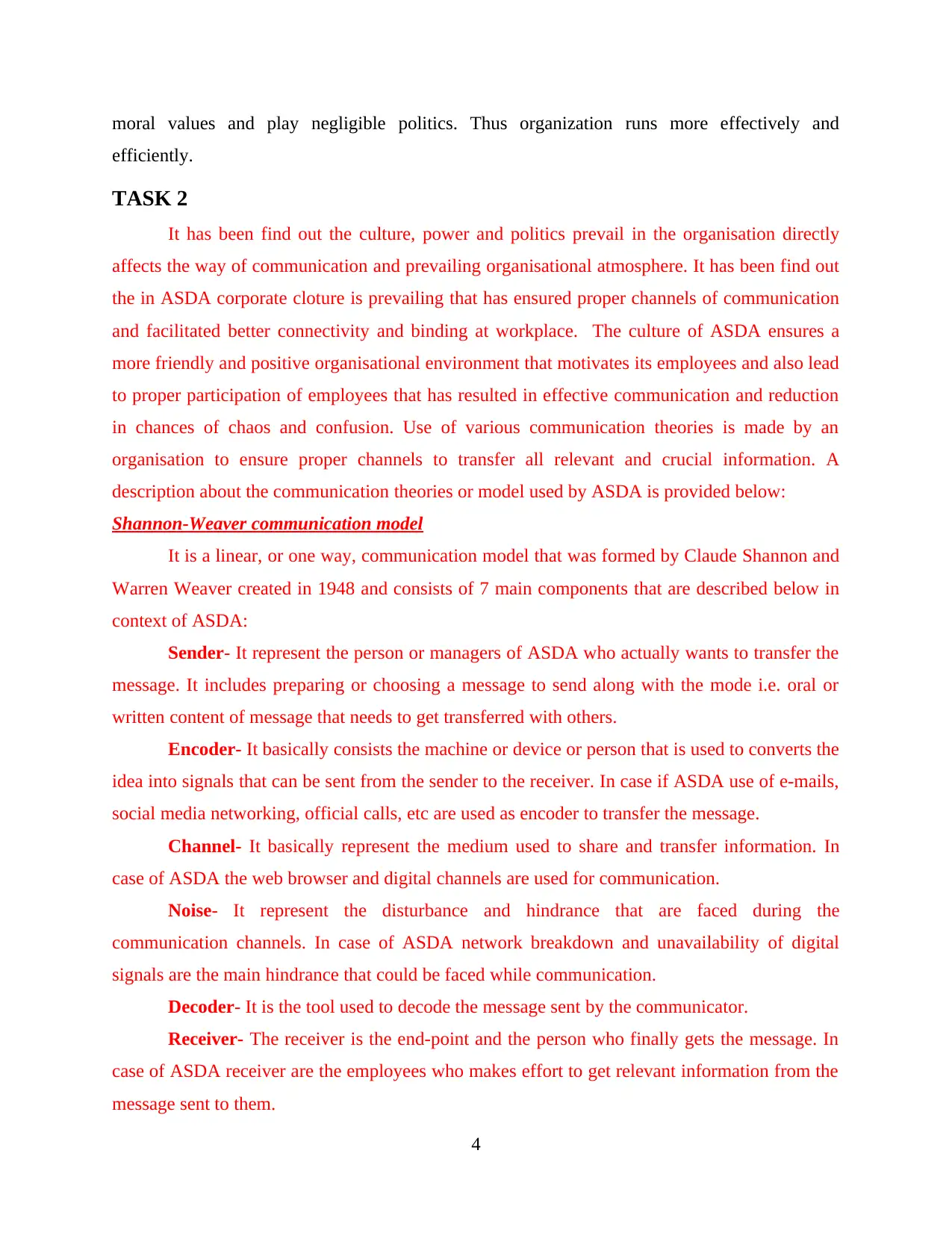
moral values and play negligible politics. Thus organization runs more effectively and
efficiently.
TASK 2
It has been find out the culture, power and politics prevail in the organisation directly
affects the way of communication and prevailing organisational atmosphere. It has been find out
the in ASDA corporate cloture is prevailing that has ensured proper channels of communication
and facilitated better connectivity and binding at workplace. The culture of ASDA ensures a
more friendly and positive organisational environment that motivates its employees and also lead
to proper participation of employees that has resulted in effective communication and reduction
in chances of chaos and confusion. Use of various communication theories is made by an
organisation to ensure proper channels to transfer all relevant and crucial information. A
description about the communication theories or model used by ASDA is provided below:
Shannon-Weaver communication model
It is a linear, or one way, communication model that was formed by Claude Shannon and
Warren Weaver created in 1948 and consists of 7 main components that are described below in
context of ASDA:
Sender- It represent the person or managers of ASDA who actually wants to transfer the
message. It includes preparing or choosing a message to send along with the mode i.e. oral or
written content of message that needs to get transferred with others.
Encoder- It basically consists the machine or device or person that is used to converts the
idea into signals that can be sent from the sender to the receiver. In case if ASDA use of e-mails,
social media networking, official calls, etc are used as encoder to transfer the message.
Channel- It basically represent the medium used to share and transfer information. In
case of ASDA the web browser and digital channels are used for communication.
Noise- It represent the disturbance and hindrance that are faced during the
communication channels. In case of ASDA network breakdown and unavailability of digital
signals are the main hindrance that could be faced while communication.
Decoder- It is the tool used to decode the message sent by the communicator.
Receiver- The receiver is the end-point and the person who finally gets the message. In
case of ASDA receiver are the employees who makes effort to get relevant information from the
message sent to them.
4
efficiently.
TASK 2
It has been find out the culture, power and politics prevail in the organisation directly
affects the way of communication and prevailing organisational atmosphere. It has been find out
the in ASDA corporate cloture is prevailing that has ensured proper channels of communication
and facilitated better connectivity and binding at workplace. The culture of ASDA ensures a
more friendly and positive organisational environment that motivates its employees and also lead
to proper participation of employees that has resulted in effective communication and reduction
in chances of chaos and confusion. Use of various communication theories is made by an
organisation to ensure proper channels to transfer all relevant and crucial information. A
description about the communication theories or model used by ASDA is provided below:
Shannon-Weaver communication model
It is a linear, or one way, communication model that was formed by Claude Shannon and
Warren Weaver created in 1948 and consists of 7 main components that are described below in
context of ASDA:
Sender- It represent the person or managers of ASDA who actually wants to transfer the
message. It includes preparing or choosing a message to send along with the mode i.e. oral or
written content of message that needs to get transferred with others.
Encoder- It basically consists the machine or device or person that is used to converts the
idea into signals that can be sent from the sender to the receiver. In case if ASDA use of e-mails,
social media networking, official calls, etc are used as encoder to transfer the message.
Channel- It basically represent the medium used to share and transfer information. In
case of ASDA the web browser and digital channels are used for communication.
Noise- It represent the disturbance and hindrance that are faced during the
communication channels. In case of ASDA network breakdown and unavailability of digital
signals are the main hindrance that could be faced while communication.
Decoder- It is the tool used to decode the message sent by the communicator.
Receiver- The receiver is the end-point and the person who finally gets the message. In
case of ASDA receiver are the employees who makes effort to get relevant information from the
message sent to them.
4
⊘ This is a preview!⊘
Do you want full access?
Subscribe today to unlock all pages.

Trusted by 1+ million students worldwide
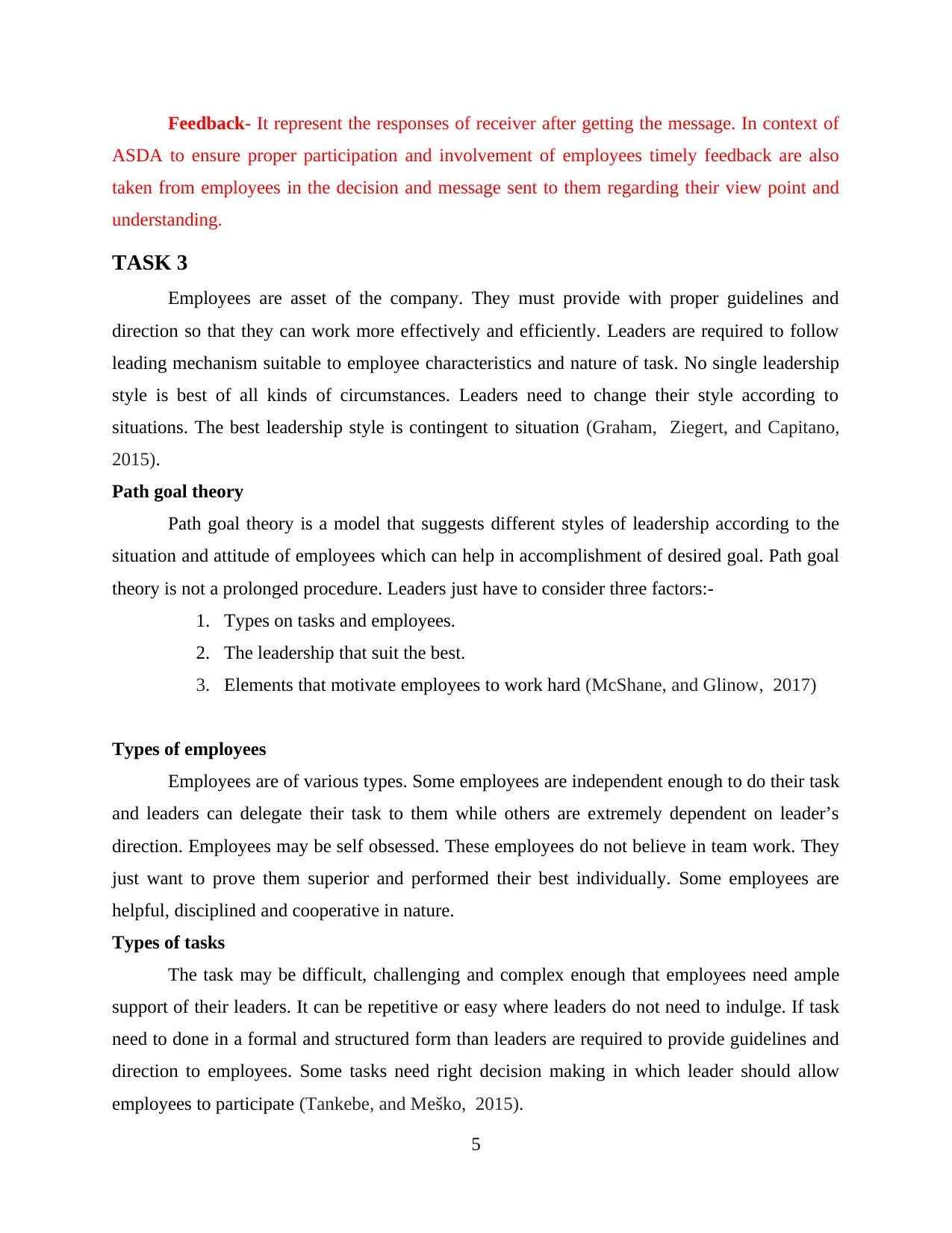
Feedback- It represent the responses of receiver after getting the message. In context of
ASDA to ensure proper participation and involvement of employees timely feedback are also
taken from employees in the decision and message sent to them regarding their view point and
understanding.
TASK 3
Employees are asset of the company. They must provide with proper guidelines and
direction so that they can work more effectively and efficiently. Leaders are required to follow
leading mechanism suitable to employee characteristics and nature of task. No single leadership
style is best of all kinds of circumstances. Leaders need to change their style according to
situations. The best leadership style is contingent to situation (Graham, Ziegert, and Capitano,
2015).
Path goal theory
Path goal theory is a model that suggests different styles of leadership according to the
situation and attitude of employees which can help in accomplishment of desired goal. Path goal
theory is not a prolonged procedure. Leaders just have to consider three factors:-
1. Types on tasks and employees.
2. The leadership that suit the best.
3. Elements that motivate employees to work hard (McShane, and Glinow, 2017)
Types of employees
Employees are of various types. Some employees are independent enough to do their task
and leaders can delegate their task to them while others are extremely dependent on leader’s
direction. Employees may be self obsessed. These employees do not believe in team work. They
just want to prove them superior and performed their best individually. Some employees are
helpful, disciplined and cooperative in nature.
Types of tasks
The task may be difficult, challenging and complex enough that employees need ample
support of their leaders. It can be repetitive or easy where leaders do not need to indulge. If task
need to done in a formal and structured form than leaders are required to provide guidelines and
direction to employees. Some tasks need right decision making in which leader should allow
employees to participate (Tankebe, and Meško, 2015).
5
ASDA to ensure proper participation and involvement of employees timely feedback are also
taken from employees in the decision and message sent to them regarding their view point and
understanding.
TASK 3
Employees are asset of the company. They must provide with proper guidelines and
direction so that they can work more effectively and efficiently. Leaders are required to follow
leading mechanism suitable to employee characteristics and nature of task. No single leadership
style is best of all kinds of circumstances. Leaders need to change their style according to
situations. The best leadership style is contingent to situation (Graham, Ziegert, and Capitano,
2015).
Path goal theory
Path goal theory is a model that suggests different styles of leadership according to the
situation and attitude of employees which can help in accomplishment of desired goal. Path goal
theory is not a prolonged procedure. Leaders just have to consider three factors:-
1. Types on tasks and employees.
2. The leadership that suit the best.
3. Elements that motivate employees to work hard (McShane, and Glinow, 2017)
Types of employees
Employees are of various types. Some employees are independent enough to do their task
and leaders can delegate their task to them while others are extremely dependent on leader’s
direction. Employees may be self obsessed. These employees do not believe in team work. They
just want to prove them superior and performed their best individually. Some employees are
helpful, disciplined and cooperative in nature.
Types of tasks
The task may be difficult, challenging and complex enough that employees need ample
support of their leaders. It can be repetitive or easy where leaders do not need to indulge. If task
need to done in a formal and structured form than leaders are required to provide guidelines and
direction to employees. Some tasks need right decision making in which leader should allow
employees to participate (Tankebe, and Meško, 2015).
5
Paraphrase This Document
Need a fresh take? Get an instant paraphrase of this document with our AI Paraphraser
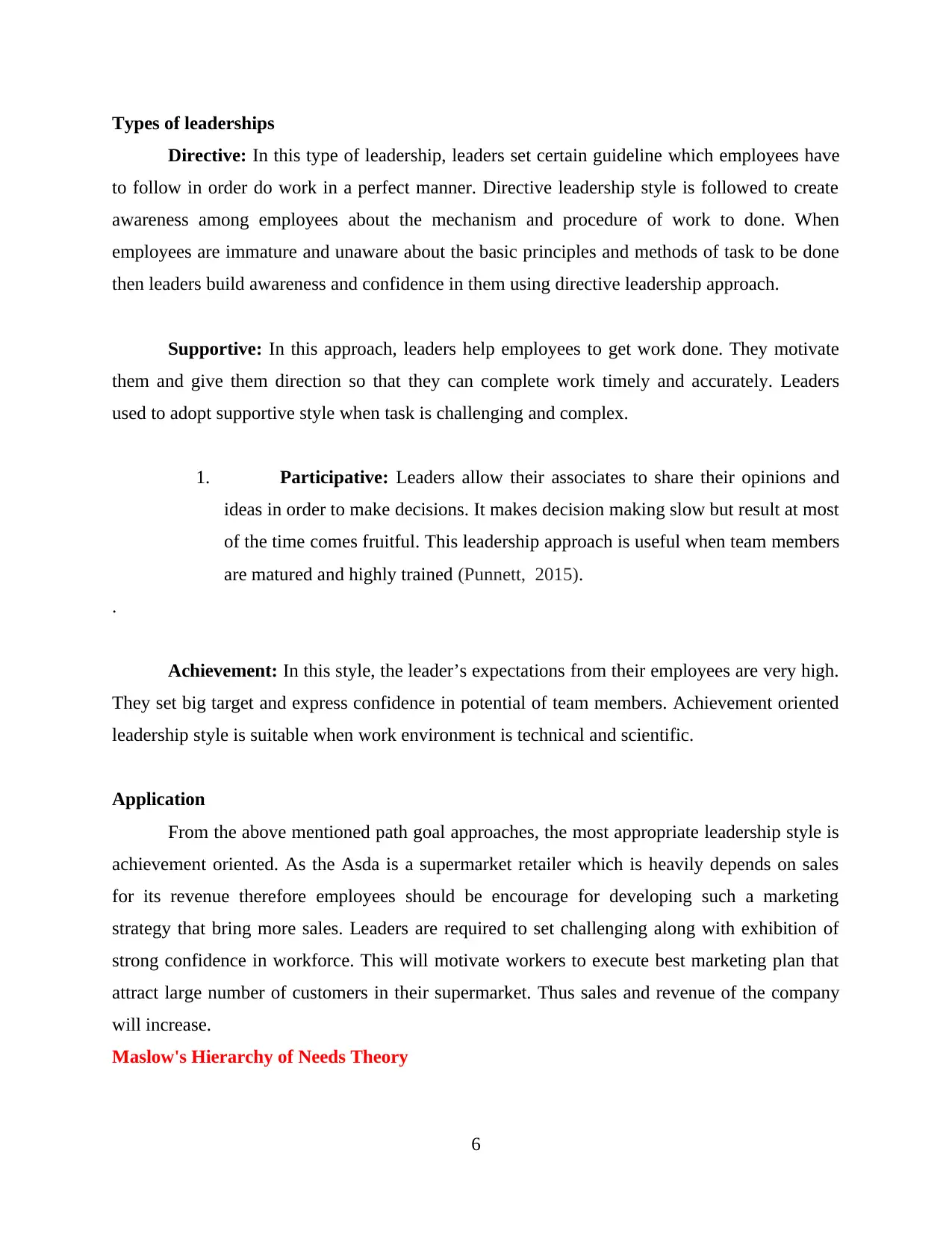
Types of leaderships
Directive: In this type of leadership, leaders set certain guideline which employees have
to follow in order do work in a perfect manner. Directive leadership style is followed to create
awareness among employees about the mechanism and procedure of work to done. When
employees are immature and unaware about the basic principles and methods of task to be done
then leaders build awareness and confidence in them using directive leadership approach.
Supportive: In this approach, leaders help employees to get work done. They motivate
them and give them direction so that they can complete work timely and accurately. Leaders
used to adopt supportive style when task is challenging and complex.
1. Participative: Leaders allow their associates to share their opinions and
ideas in order to make decisions. It makes decision making slow but result at most
of the time comes fruitful. This leadership approach is useful when team members
are matured and highly trained (Punnett, 2015).
.
Achievement: In this style, the leader’s expectations from their employees are very high.
They set big target and express confidence in potential of team members. Achievement oriented
leadership style is suitable when work environment is technical and scientific.
Application
From the above mentioned path goal approaches, the most appropriate leadership style is
achievement oriented. As the Asda is a supermarket retailer which is heavily depends on sales
for its revenue therefore employees should be encourage for developing such a marketing
strategy that bring more sales. Leaders are required to set challenging along with exhibition of
strong confidence in workforce. This will motivate workers to execute best marketing plan that
attract large number of customers in their supermarket. Thus sales and revenue of the company
will increase.
Maslow's Hierarchy of Needs Theory
6
Directive: In this type of leadership, leaders set certain guideline which employees have
to follow in order do work in a perfect manner. Directive leadership style is followed to create
awareness among employees about the mechanism and procedure of work to done. When
employees are immature and unaware about the basic principles and methods of task to be done
then leaders build awareness and confidence in them using directive leadership approach.
Supportive: In this approach, leaders help employees to get work done. They motivate
them and give them direction so that they can complete work timely and accurately. Leaders
used to adopt supportive style when task is challenging and complex.
1. Participative: Leaders allow their associates to share their opinions and
ideas in order to make decisions. It makes decision making slow but result at most
of the time comes fruitful. This leadership approach is useful when team members
are matured and highly trained (Punnett, 2015).
.
Achievement: In this style, the leader’s expectations from their employees are very high.
They set big target and express confidence in potential of team members. Achievement oriented
leadership style is suitable when work environment is technical and scientific.
Application
From the above mentioned path goal approaches, the most appropriate leadership style is
achievement oriented. As the Asda is a supermarket retailer which is heavily depends on sales
for its revenue therefore employees should be encourage for developing such a marketing
strategy that bring more sales. Leaders are required to set challenging along with exhibition of
strong confidence in workforce. This will motivate workers to execute best marketing plan that
attract large number of customers in their supermarket. Thus sales and revenue of the company
will increase.
Maslow's Hierarchy of Needs Theory
6
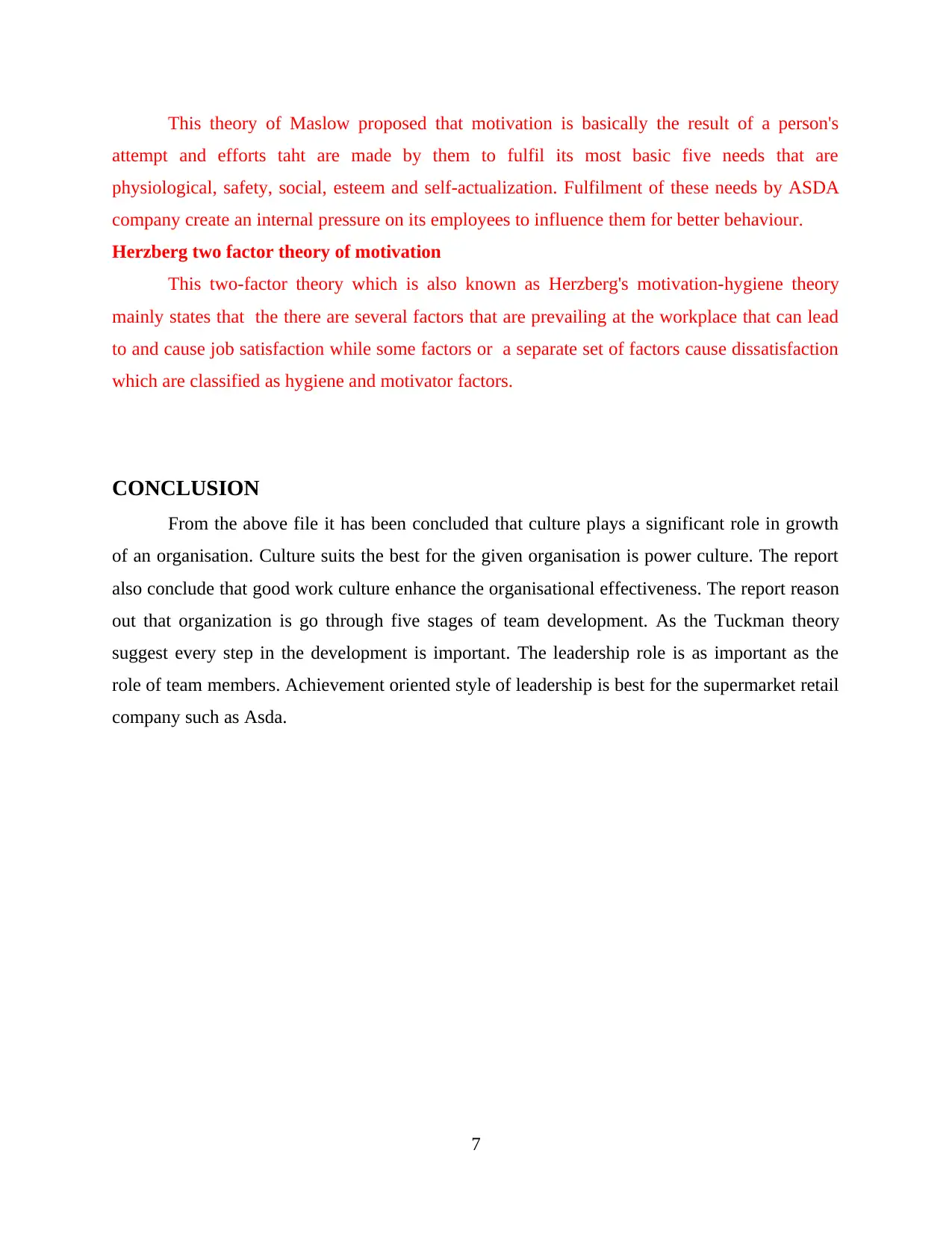
This theory of Maslow proposed that motivation is basically the result of a person's
attempt and efforts taht are made by them to fulfil its most basic five needs that are
physiological, safety, social, esteem and self-actualization. Fulfilment of these needs by ASDA
company create an internal pressure on its employees to influence them for better behaviour.
Herzberg two factor theory of motivation
This two-factor theory which is also known as Herzberg's motivation-hygiene theory
mainly states that the there are several factors that are prevailing at the workplace that can lead
to and cause job satisfaction while some factors or a separate set of factors cause dissatisfaction
which are classified as hygiene and motivator factors.
CONCLUSION
From the above file it has been concluded that culture plays a significant role in growth
of an organisation. Culture suits the best for the given organisation is power culture. The report
also conclude that good work culture enhance the organisational effectiveness. The report reason
out that organization is go through five stages of team development. As the Tuckman theory
suggest every step in the development is important. The leadership role is as important as the
role of team members. Achievement oriented style of leadership is best for the supermarket retail
company such as Asda.
7
attempt and efforts taht are made by them to fulfil its most basic five needs that are
physiological, safety, social, esteem and self-actualization. Fulfilment of these needs by ASDA
company create an internal pressure on its employees to influence them for better behaviour.
Herzberg two factor theory of motivation
This two-factor theory which is also known as Herzberg's motivation-hygiene theory
mainly states that the there are several factors that are prevailing at the workplace that can lead
to and cause job satisfaction while some factors or a separate set of factors cause dissatisfaction
which are classified as hygiene and motivator factors.
CONCLUSION
From the above file it has been concluded that culture plays a significant role in growth
of an organisation. Culture suits the best for the given organisation is power culture. The report
also conclude that good work culture enhance the organisational effectiveness. The report reason
out that organization is go through five stages of team development. As the Tuckman theory
suggest every step in the development is important. The leadership role is as important as the
role of team members. Achievement oriented style of leadership is best for the supermarket retail
company such as Asda.
7
⊘ This is a preview!⊘
Do you want full access?
Subscribe today to unlock all pages.

Trusted by 1+ million students worldwide
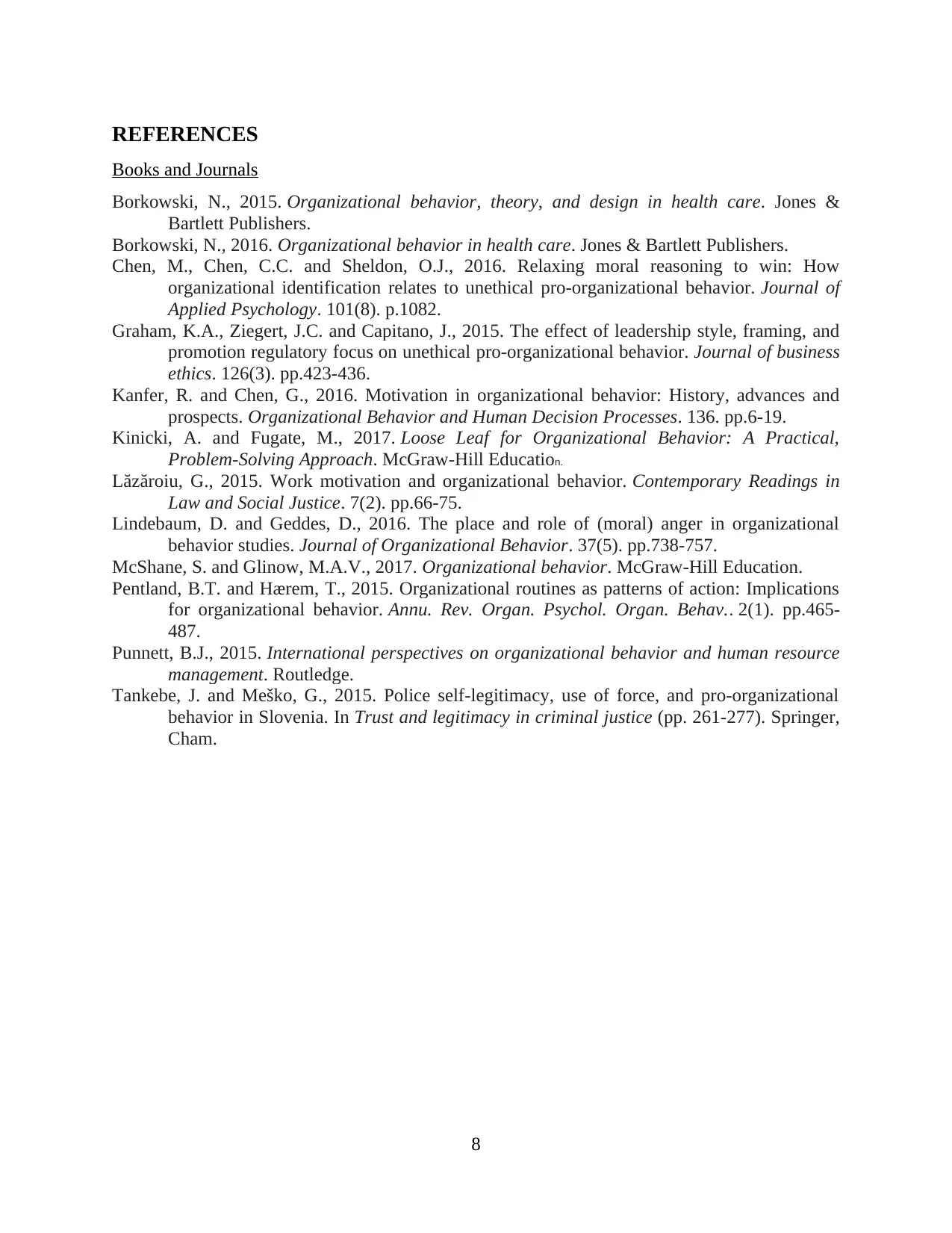
REFERENCES
Books and Journals
Borkowski, N., 2015. Organizational behavior, theory, and design in health care. Jones &
Bartlett Publishers.
Borkowski, N., 2016. Organizational behavior in health care. Jones & Bartlett Publishers.
Chen, M., Chen, C.C. and Sheldon, O.J., 2016. Relaxing moral reasoning to win: How
organizational identification relates to unethical pro-organizational behavior. Journal of
Applied Psychology. 101(8). p.1082.
Graham, K.A., Ziegert, J.C. and Capitano, J., 2015. The effect of leadership style, framing, and
promotion regulatory focus on unethical pro-organizational behavior. Journal of business
ethics. 126(3). pp.423-436.
Kanfer, R. and Chen, G., 2016. Motivation in organizational behavior: History, advances and
prospects. Organizational Behavior and Human Decision Processes. 136. pp.6-19.
Kinicki, A. and Fugate, M., 2017. Loose Leaf for Organizational Behavior: A Practical,
Problem-Solving Approach. McGraw-Hill Education.
Lăzăroiu, G., 2015. Work motivation and organizational behavior. Contemporary Readings in
Law and Social Justice. 7(2). pp.66-75.
Lindebaum, D. and Geddes, D., 2016. The place and role of (moral) anger in organizational
behavior studies. Journal of Organizational Behavior. 37(5). pp.738-757.
McShane, S. and Glinow, M.A.V., 2017. Organizational behavior. McGraw-Hill Education.
Pentland, B.T. and Hærem, T., 2015. Organizational routines as patterns of action: Implications
for organizational behavior. Annu. Rev. Organ. Psychol. Organ. Behav.. 2(1). pp.465-
487.
Punnett, B.J., 2015. International perspectives on organizational behavior and human resource
management. Routledge.
Tankebe, J. and Meško, G., 2015. Police self-legitimacy, use of force, and pro-organizational
behavior in Slovenia. In Trust and legitimacy in criminal justice (pp. 261-277). Springer,
Cham.
8
Books and Journals
Borkowski, N., 2015. Organizational behavior, theory, and design in health care. Jones &
Bartlett Publishers.
Borkowski, N., 2016. Organizational behavior in health care. Jones & Bartlett Publishers.
Chen, M., Chen, C.C. and Sheldon, O.J., 2016. Relaxing moral reasoning to win: How
organizational identification relates to unethical pro-organizational behavior. Journal of
Applied Psychology. 101(8). p.1082.
Graham, K.A., Ziegert, J.C. and Capitano, J., 2015. The effect of leadership style, framing, and
promotion regulatory focus on unethical pro-organizational behavior. Journal of business
ethics. 126(3). pp.423-436.
Kanfer, R. and Chen, G., 2016. Motivation in organizational behavior: History, advances and
prospects. Organizational Behavior and Human Decision Processes. 136. pp.6-19.
Kinicki, A. and Fugate, M., 2017. Loose Leaf for Organizational Behavior: A Practical,
Problem-Solving Approach. McGraw-Hill Education.
Lăzăroiu, G., 2015. Work motivation and organizational behavior. Contemporary Readings in
Law and Social Justice. 7(2). pp.66-75.
Lindebaum, D. and Geddes, D., 2016. The place and role of (moral) anger in organizational
behavior studies. Journal of Organizational Behavior. 37(5). pp.738-757.
McShane, S. and Glinow, M.A.V., 2017. Organizational behavior. McGraw-Hill Education.
Pentland, B.T. and Hærem, T., 2015. Organizational routines as patterns of action: Implications
for organizational behavior. Annu. Rev. Organ. Psychol. Organ. Behav.. 2(1). pp.465-
487.
Punnett, B.J., 2015. International perspectives on organizational behavior and human resource
management. Routledge.
Tankebe, J. and Meško, G., 2015. Police self-legitimacy, use of force, and pro-organizational
behavior in Slovenia. In Trust and legitimacy in criminal justice (pp. 261-277). Springer,
Cham.
8
1 out of 10
Related Documents
Your All-in-One AI-Powered Toolkit for Academic Success.
+13062052269
info@desklib.com
Available 24*7 on WhatsApp / Email
![[object Object]](/_next/static/media/star-bottom.7253800d.svg)
Unlock your academic potential
Copyright © 2020–2025 A2Z Services. All Rights Reserved. Developed and managed by ZUCOL.




